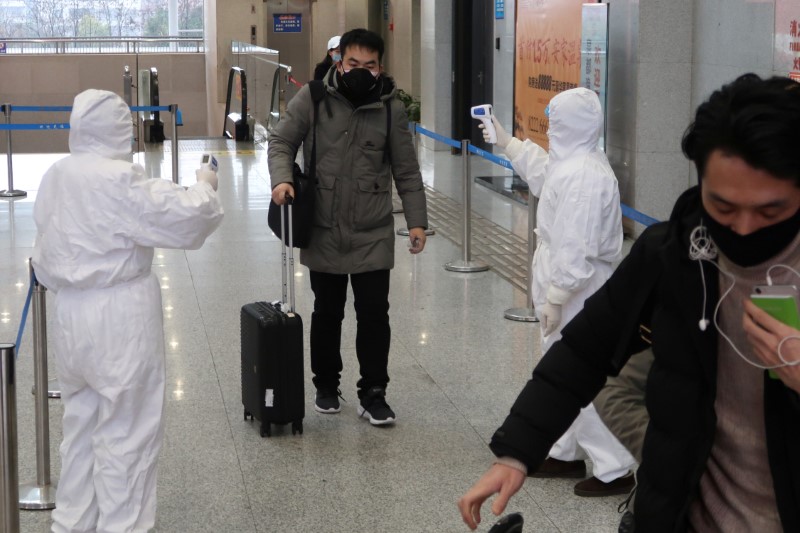
By Judy Hua and Cate Cadell
BEIJING, China (Reuters) – China shut part of the Great Wall and suspended public transport in 10 cities, stranding millions of people at the start of the Lunar New Year holiday on Friday as authorities rush to contain a virus that has killed 26 people and infected more than 800.
The World Health Organization (WHO) has declared the new coronavirus an “emergency in China” but stopped short of declaring it of international concern.

People line up outside a drugstore to buy masks in Shanghai, China January 24, 2020. REUTERS/Aly Song
While restrictions on travel and gatherings have already been imposed to curb the outbreak, China will take stricter and more targeted measures, state television reported citing a State Council meeting on Friday, but gave no further details.
“The spread of the virus has not been cut off … Local authorities should take more responsibility and have a stronger sense of urgency,” state broadcaster CCTV said.
The Defence Ministry said it is organizing military medical experts to take part in the fight against the virus, without giving details.
Most of the cases and all of the deaths have been in China, but the virus has also been detected in Thailand, Vietnam, Singapore, Japan, South Korea, Taiwan, Nepal and the United States.
Britain convened an emergency response meeting on Friday.
While health officials have been at pains to say it is too soon to evaluate the severity of the outbreak, the newly identified coronavirus has triggered alarm because it is too early to know how dangerous it is and how easily it spreads.
Symptoms include fever, difficulty breathing and coughing. Most of the fatalities have been elderly, many with pre-existing conditions, the WHO said.
As of Thursday, there were 830 confirmed cases and 26 people had died there, China’s National Health Commission said.
WUHAN ISOLATED
Most cases have been in Wuhan, where the virus is believed to have originated in a market that traded illegally in wildlife. Preliminary research suggested it crossed to humans from snakes.
China has advised people to avoid crowds and 10 cities in the central province of Hubei, where Wuhan is located, have suspended some transport, the Hubei Daily reported.
The week-long celebrations to welcome the Year of the Rat began on Friday, raising fears the infection rate could accelerate as hundreds of millions of people have already traveled to see family at home and abroad.
The city of 11 million people, and neighboring Huanggang, a city of 7 million, were in virtual lockdown. Nearly all flights at Wuhan’s airport had been canceled. Airports worldwide have stepped up the screening of passengers from China.
Checkpoints blocked the main roads leading out of town, and police checked incoming vehicles for wild animals.
About 10 people got off a high-speed train that pulled into Wuhan on Friday afternoon but nobody got on before it resumed its journey. Although it stopped there, Wuhan had been removed from the train’s schedule.
“What choice do I have? It’s Chinese New Year. We have to see our family,” said a man getting off the train who gave his family name Hu.
Some sections of the Great Wall near Beijing will be closed from Saturday, state media said.
Some temples have also closed, including Beijing’s Lama Temple where people make offerings for the new year, have also been closed as has the Forbidden City, the capital’s most famous tourist attraction.
Shanghai Disneyland will close from Saturday. The theme park has a 100,000 daily capacity and sold out during last year’s new year holiday. Film premieres have also been postponed and McDonald’s suspended business in five cities in Hubei province.
In Wuhan, where the outbreak began last month, pharmacies were running out of supplies and hospitals were flooded with nervous resident seeking medical checks.
The city was rushing to build a 1,000-bed hospital for the infected by Monday, the official Changjiang Daily reported.
“There’s so much news, so much data, every 10 minutes there’s an update, it’s frightening, especially for people like us in a severely hit area,” Lily Jin, 30, a resident of the city, told Reuters by phone.
VACCINE QUEST
The WHO said on Thursday it was a “bit too early” to designate the outbreak a public health emergency of international concern, which would require countries to step up their response.
Some experts believe the virus is not as dangerous as the one that caused the 2002-03 outbreak of Severe Acute Respiratory Syndrome, which also began in China and killed nearly 800 people, or the one that caused Middle East Respiratory Syndrome (MERS), which has killed more than 700 people since 2012.
There is no known vaccine or particular treatment yet.
“There is some work being done and there are some trials now for MERS (vaccines). And we may look at some point whether those treatments and vaccines would have some effect on this novel coronavirus,” WHO spokesman Tarik Jasarevic said on Friday.
Gilead Sciences Inc said it was assessing whether its experimental Ebola treatment could be used. Meanwhile, three research teams were starting work on vaccines, the Coalition for Epidemic Preparedness Innovations said.
The virus is expected to dent China’s growth after months of economic worries over trade tensions with the United States, unnerving foreign companies doing business there.
Shares in luxury goods firms have suffered from the anticipated drop in demand from China, and on Friday French spirits group Remy Cointreau said it was “clearly concerned” about the potential impact.
(Reporting by Roxanne Liu, David Stanway, Martin Pollard, Tony Munroe, Muyu Xu, Engen Tham, Cate Cadell, Judy Hua and Ben Blanchard; Writing by Michael Perry, Robert Birsel; Editing by Simon Cameron-Moore and Alison Williams)












